The museum is gigantic, and has a huge number of items on permanent display. In our two days we saw much less than half of everything; we could have happily spent many more days poring over the items. Like many of the London museums, entry is completely free (though they suggest a three-pound donation).
The museum has artifacts from an astounding array of cultures and time periods, including ancient Egypt (they have the Rosetta Stone), ancient Greece & Rome, Britain & Europe (with a large section on Roman Britain), early and later Mesopotamia (including ancient Assyria), China, Japan, southeast Asia, Africa, and Islamic countries.
The diversity of cultures contained enhances the experience, and encourages comparisons between the different time periods and regions of the world. For instance, while the Egyptians were building huge pyramids and carving incredible artwork in huge slabs of stone, the people of Britain were mostly just chipping arrowheads from rock and etching their artwork on bones.
We focused our time on the Egyptian, Greek/Roman, Asian, and historical British galleries, though we also tried to browse around a few others before we were kicked out by the guards.
Like everyone else who visits the museum, we took the obligatory pictures of ourselves standing in front of the Rosetta Stone. Reading up on the history of the stone was depressing (like it so often is with items from human history); apparently it was discovered only after it had been broken out of its original location and used in the construction of a military fortification.
Once we pulled ourselves away from the crowds around the Rosetta Stone, we found the cutest little slug hieroglyph:
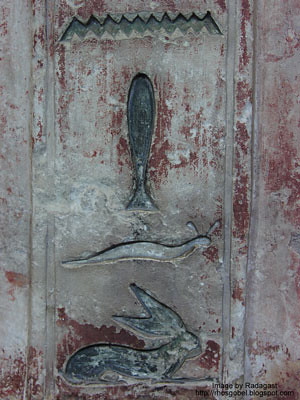
Hieroglyphs on a limestone false door from the fifth dynasty (~2,400 BC)
It was neat to see that 4,000 years ago people actually appreciated mollusks (though I didn't see any snails or cephalopods, sadly). I wonder what the slug means ...
More good (if not entirely anatomically correct) biological-themed sculpture was made by the Assyrians:
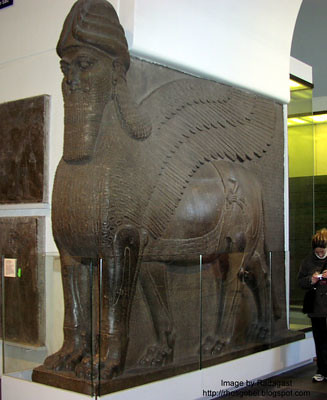
Human-headed winged lion from Assyria, ~865-860BC
The neat thing about the lion sculpture is the number of legs: it has five. The statue looks anatomically correct (ignoring the human head and wings) when viewed directly from either the front or the side, but not from an angle. Apparently this chimera (and its twin) was supposed to protect the entry to the throneroom of Ashurnasirpal II's palace. There was also a winged bull version, one of which had a little game board scratched into it (likely used by bored guards).
The museum's (now rather controversial) Parthenon sculptures were in a spacious room. Each piece of sculpture (panel of the frieze, statue fragment, etc.) had a detailed description along with it, and it was educational to just walk along the entire length of frieze and read the story that was being told.
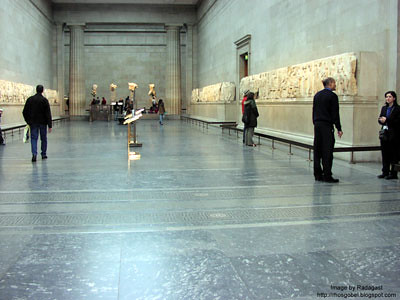
The display gallery holding the actual marbles collected by Lord Elgin from the Parthenon
The frieze details a procession honoring Athena, including a wide variety of participants such as riders struggling with their horses, charioteers, women carrying offerings, and even a few gods. There were even marshals positioned between segments of the procession to stop them from appearing to run into each other (or off the end of the building). It was something like reading a volume of manga carved into stone.
What was even more impressive, though, was the amount of detail on the Parthenon marbles. Take, for instance, the image in the picture below – you can clearly see, among other things, the veins on the horse's leg. The detail is especially impressive considering that these frieze pieces were designed to be installed more than 30 feet above the ground.
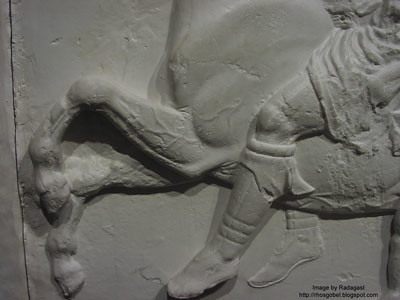
Plaster cast of a portion of the Parthenon's frieze (Elgin made plaster casts of the portions of the Parthenon's frieze that he did not bring back to England, some of these are also displayed)
The museum is chock-full of beautiful things, which often surprised us when we came across them. For instance, when we were trying to get upstairs after looking at the Greek sculptures, we found that the stairway was lined with gorgeous mosaics.
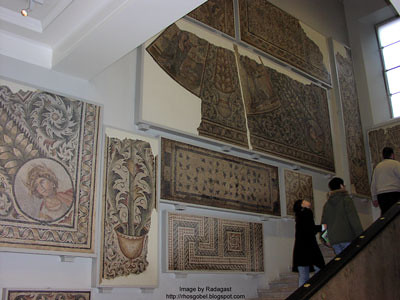
Mosaics in a staircase at the British Museum
The face in the mosaic on the left of the picture above was impressively realistically done, with very believable skin tones and facial features created using exceptionally small pieces of tile.
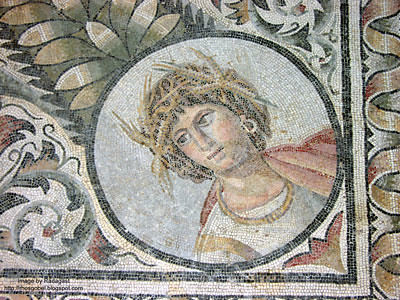
Close-up of a face in a mosaic
The museum also had some Roman mosaics displayed elsewhere, and this mosaic of seafood from the Mediterranean caught my eye:

Roman mosaic of seafood from ~100AD, including an octopus, lobster, eel, and many fish.
Most of the fish in the mosaic are apparently identifiable down to species, and the museum lists the probable identifications next to the mosaic. Seeing all these mosaics makes me want to do a mosaic in one of the rooms of our house (but then imagining all the work quickly banishes the thought from my mind).
They also had more food in the museum, and not just the kind served in the museum's restaurants:

Preserved food offerings from tombs dating to ~1,500BC
Pictured above are loaves of bread, pomegranates, a cake made from dates, and duck (on the basket, along with more loaves of bread), all more than 3,000 years old. With so much detailed art, and even some preserved specimens, it would be interesting to compare the varieties (and species) of food items used in ancient times to those used presently. It would probably be a neat study of the effect of artificial (and natural) selection on plants and animals.
We also saw a number of cuneiform tablets while we were there, but those will have to wait for another post, as this one has gotten quite long.



No comments:
Post a Comment